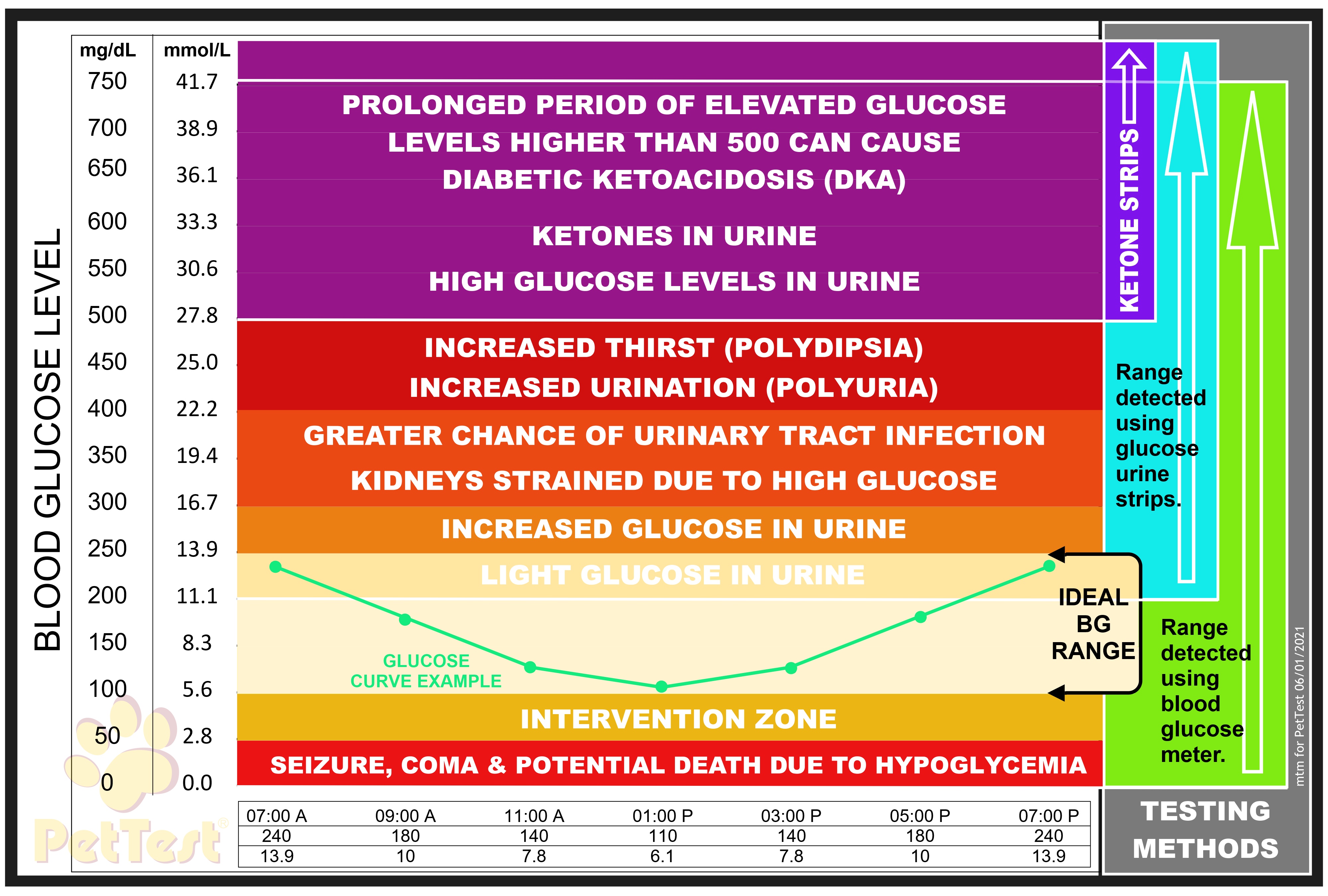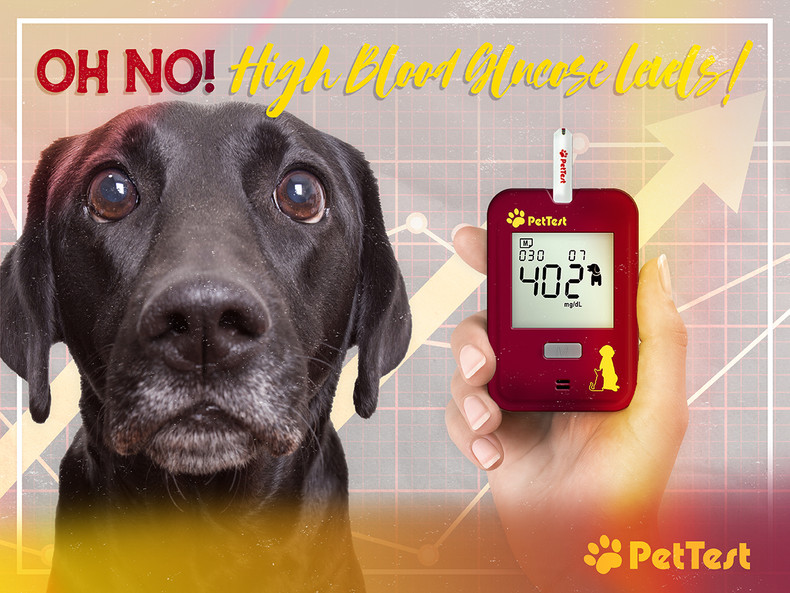OH NO! High Blood Glucose Levels!
We all have these OH NO! moments with our diabetic dogs whether we are new to diabetes diagnosis or not. Even after treating Lucy for diabetes and pancreatitis since August 2015, in 2019 & 2020 I had these moments and needed to lean on wise friends for suggestions, support and guidance.
Lucy had elevated blood glucose levels, no UTI, no other infections, blood panel looked good, and we could not figure out what was going on. She loved chicken and was fed that as part of her meals. Switching protein was suggested to me and when I did her blood glucose levels dropped! It turns out that over the years Lucy became sensitive to chicken and this caused her blood glucose to skyrocket.
Sometimes when we are living it, a neutral party will have better perspective. Brainstorming can really help, and sometimes the answer is simple but the sugar parent misses it.
Today I want to talk about some common complications with our diabetic dogs. We will look at high blood glucose levels and possible reasons for them. Any time blood glucose levels are uncontrolled for a length of time, a call to the vet is in order. Your vet may want to run a blood panel to rule out any potential problems.

After testing blood glucose levels and getting a high reading, retest to ensure that you have a good blood sample size. When we do not get a good blood sample we can get off readings, so we always suggest retesting immediately, this rules out error.
Is the meter coded to the correct species? Animal meters can have a dog or cat mode or the species code will be printed on the test strip bottle.
If blood glucose readings are accurate and you are using the correct animal mode/code, there are many possible reasons but let’s explore more common causes for high blood glucose.
Ketones
We recommend testing urine for ketone levels any time a dog is over 300 mg/dL (16.6 mmol/L) because high blood glucose levels can cause the liver to produce ketones instead of utilizing glucose properly since there is not enough insulin. If your dog has trace ketones you need to encourage water consumption to help flush out ketones. A buildup of ketones causes diabetic ketoacidosis (DKA) and DKA is fatal if not treated. Ketones above trace require vet attention as soon as possible. You can read more about this in a past blog by clicking here.
Negative ketones is good news, just encourage water by adding some bone broth or a sprinkle of parmesan cheese to the water bowl. This will help flush out excess glucose.
Urinary Tract Infections
If your pup is urinating frequently, licking that area a lot, feels the need to urinate but nothing comes out, potty accidents, or urine is cloudy or dark it is possible that your dog has a urinary tract infection (UTI). UTI’s are common in diabetic dogs because excess glucose is dumped by the kidneys into the bladder. Urine sits in the bladder until it is expelled, and glucose breeds bacteria. If you have UTI urine strips, test your dog to see whether they have a UTI. This is good information for your vet as well.
Fur Shots
Sometimes when we inject insulin the dog moves, the needle goes through the skin, or we move wrong and the insulin does not get delivered properly. We can usually smell the insulin on their fur, it has a strong odor and is similar to the smell of Band-Aids. If you give your dog a fur shot DO NOT REINJECT. You have no way of knowing how much insulin your dog got and by reinjecting you risk hypoglycemia. When this happens, encourage water consumption, take your dog for a walk if you know that exercise drops blood glucose levels, and you can adjust feeding/insulin time by 30 - 60 minutes.
Missed Doses
Life gets busy and sometimes we miss giving insulin. If this happens and it has not been over an hour since food was eaten, you can give full dose of insulin if blood glucose levels are over 200. If it has been too long since food was eaten then you will need to encourage water consumption, test for ketones, and exercise if doing so drops blood glucose levels. You can adjust feeding/insulin time 30-60 minutes to give insulin a bit early.
Renal Problems
If the kidneys are not functioning properly due to kidney infection, kidney disease or kidney failure, blood is not being filtered properly. Excess glucose is filtered out of the blood by the kidneys and dumped into the bladder as waste. To test for kidney function your vet will run a blood panel, the following diagnostics are kidney specific: Creatinine (CREA), BUN and Phosphorus (PHOS). If your dog has elevated kidney values in blood work and kidney disease is diagnosed, a urinalysis should be run to rule out protein in urine.
Hepatic Issues
The liver is a workhorse and does so much, including converting glycogen into glucose for energy. If your dog has liver disease or infection this can affect blood glucose levels. Certain hepatic diseases can cause hyperglycemia or hypoglycemia. If you suspect liver issues, you should have a blood panel done. Liver specific diagnostics in blood work are Albumin (ALB), ALT, ALP, GGT, and Bilirubin. Click here to read more about the liver.
Rebound / Somogyi Effect
When a dog gets too much insulin the body goes into emergency mode. The liver saves the body from hypoglycemia by dumping glucose into the bloodstream and it can take several days to break this emergency response. This can happen when insulin is increased by too much or blood glucose levels drop too low. We can see high flat blood glucose curves that look like insulin resistance, or we can see a blood glucose curve that looks like a checkmark. If rebound / Somogyi Effect is a possibility, it is recommended to reduce insulin for six doses to break the cycle.
Gastrointestinal Issues
Our dogs are prone to pancreatitis, which is a painful illness where the digestive enzymes activate in the pancreas, causing inflammation and damage to the pancreas. Irritable bowel syndrome (IBS), gastritis, hemorrhagic gastroenteritis (HE) are also painful GI issues that can affect blood glucose levels. If your dog is not eating, lethargic, has loose stools or seems to be in pain please call your vet for an appointment.
Dental Infections
Dental health is particularly important with diabetics, they tend to get dry mouth, and this affects the gums and teeth, saliva helps prevent tooth decay. If you suspect your dog has an infected or bad tooth, please make a vet appointment to have the tooth pulled. Infections and pain will cause elevated blood glucose levels, and bad teeth can also cause heart disease.
Eye Problems
Eye problems are common with dogs since diabetes can cause diabetic cataracts. We also see dry eye, glaucoma, uveitis and ulcers frequently. Diabetic cataracts cause blindness, and if a dog goes blind quickly they can become stressed, and stress can raise blood glucose levels. Dry eye can be very irritating, glaucoma causes pressure in the eyes and is painful, uveitis is inflammation of the eye and ulcers are painful. If you notice eye changes, this can be the reason for elevated blood glucose levels and a vet appointment is required ASAP.
I hope this blog helps you understand some of the things that can cause elevated blood glucose levels. A couple of things that will also help you track your dog’s glucose levels is a daily journal with blood glucose levels, eating habits and any changes listed. The PetTest Digital Companion is another great tool to help track all these things and is available for Androids and iOS devices.
If you are looking for a Facebook community to join for support, I have been an admin in Diabetic Dog Owners for over four years. You can also join Canine Diabetes Support and Information on Facebook as well.
For more conversations, photos, and giveaways check out PetTest on Facebook and Instagram.
Products mentioned in the blog:
PetTest Blood Glucose Meter Kit
PetTest Ketone Glucose Urinalysis Strips
PetTest Urinary Tract Infection Test Strips (available for preorder now!)
Do you want to print this blog for future reference? Click here!

